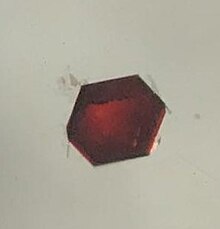
| |

| |
| Names | |
|---|---|
| IUPAC name
Bis(η8-cyclooctatetraenyl)plutonium(IV)
| |
| Other names
Plutonium cyclooctatetraenide
Pu(COT)2 | |
| Identifiers | |
3D model (JSmol)
|
|
PubChem CID
|
|
| |
| |
| Properties | |
| C16H16Pu | |
| Molar mass | 452 g·mol−1 |
| Appearance | cherry red crystals |
| insoluble, does not react with water | |
| Solubility in chlorocarbons | sparingly soluble (ca. 0.5 g/L) |
| Hazards | |
| Occupational safety and health (OHS/OSH): | |
Main hazards
|
radiation hazard, pyrophoric, toxic |
Except where otherwise noted, data are given for materials in their standard state (at 25 °C [77 °F], 100 kPa).
| |
Plutonocene, Pu(C8H8)2, is an organoplutonium compound composed of a plutonium atom sandwiched between two cyclooctatetraenide (COT2-) rings. It is a dark red, very air-sensitive solid that is sparingly soluble in toluene and chlorocarbons.[1][2] Plutonocene is a member of the actinocene family of metallocenes incorporating actinide elements in the +4 oxidation state.
Compared to other actinocenes such as uranocene, plutonocene has been studied to a lesser degree since the 1980s due to the notable radiation hazard posed by the compound.[3][4] Instead, it has mostly been the subject of theoretical studies relating to the bonding in the molecule.[4][5]
- ^ Karraker, David G.; Stone, John Austin; Jones, Erwin Rudolph; Edelstein, Norman (1970-08-01). "Bis(cyclooctatetraenyl)neptunium(IV) and bis(cyclooctatetraenyl)plutonium(IV)". Journal of the American Chemical Society. 92 (16): 4841–4845. doi:10.1021/ja00719a014. ISSN 0002-7863.
- ^ Greenwood, Norman N.; Earnshaw, Alan (1997). Chemistry of the Elements (2nd ed.). Boston, Mass.: Butterworth-Heinemann. pp. 1278–1280. ISBN 978-0-08-037941-8.
- ^ Cite error: The named reference
:7was invoked but never defined (see the help page). - ^ a b Apostolidis, Christos; Walter, Olaf; Vogt, Jochen; Liebing, Phil; Maron, Laurent; Edelmann, Frank T. (2017). "A Structurally Characterized Organometallic Plutonium(IV) Complex". Angewandte Chemie International Edition. 56 (18): 5066–5070. doi:10.1002/anie.201701858. ISSN 1521-3773. PMC 5485009. PMID 28371148.
- ^ Kerridge, Andrew (2013-11-06). "Oxidation state and covalency in f-element metallocenes (M = Ce, Th, Pu): a combined CASSCF and topological study". Dalton Transactions. 42 (46): 16428–16436. doi:10.1039/C3DT52279B. ISSN 1477-9234. PMID 24072035.
